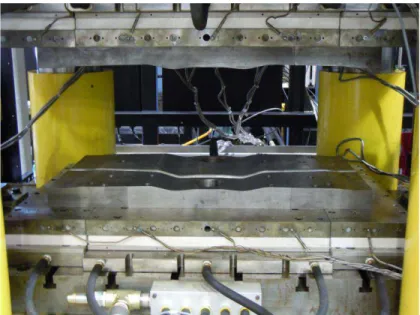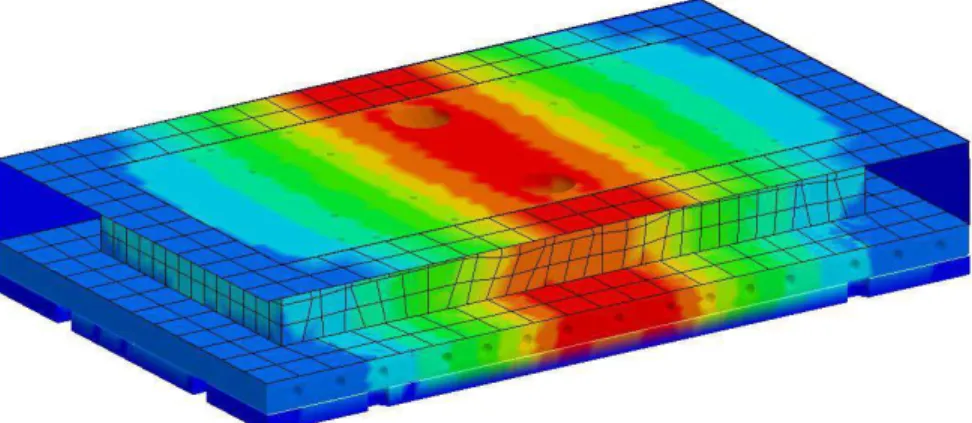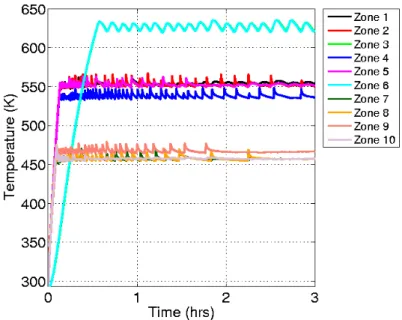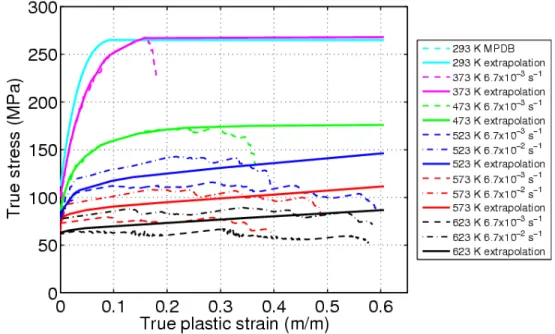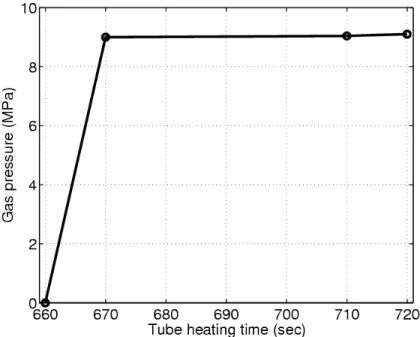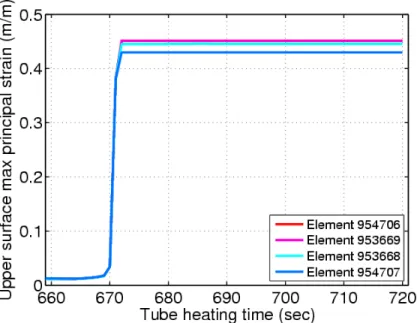Publisher’s version / Version de l'éditeur:
8th European LS-DYNA Users Conference Proceedings, 2011-05-23
READ THESE TERMS AND CONDITIONS CAREFULLY BEFORE USING THIS WEBSITE. https://nrc-publications.canada.ca/eng/copyright
Vous avez des questions? Nous pouvons vous aider. Pour communiquer directement avec un auteur, consultez la
première page de la revue dans laquelle son article a été publié afin de trouver ses coordonnées. Si vous n’arrivez pas à les repérer, communiquez avec nous à PublicationsArchive-ArchivesPublications@nrc-cnrc.gc.ca.
Questions? Contact the NRC Publications Archive team at
PublicationsArchive-ArchivesPublications@nrc-cnrc.gc.ca. If you wish to email the authors directly, please see the first page of the publication for their contact information.
NRC Publications Archive
Archives des publications du CNRC
This publication could be one of several versions: author’s original, accepted manuscript or the publisher’s version. / La version de cette publication peut être l’une des suivantes : la version prépublication de l’auteur, la version acceptée du manuscrit ou la version de l’éditeur.
Access and use of this website and the material on it are subject to the Terms and Conditions set forth at
Warm Hydroforming Simulation of 7075 Aluminium Alloy Tubes Using
LS-DYNA
D'Amours, Guillaume; Béland, Jean-Françcois
https://publications-cnrc.canada.ca/fra/droits
L’accès à ce site Web et l’utilisation de son contenu sont assujettis aux conditions présentées dans le site LISEZ CES CONDITIONS ATTENTIVEMENT AVANT D’UTILISER CE SITE WEB.
NRC Publications Record / Notice d'Archives des publications de CNRC:
https://nrc-publications.canada.ca/eng/view/object/?id=b82da04e-2d61-4abc-915b-d774b0bbc678 https://publications-cnrc.canada.ca/fra/voir/objet/?id=b82da04e-2d61-4abc-915b-d774b0bbc678
Warm Hydroforming Simulation of 7075 Aluminium
Alloy Tubes Using LS-DYNA
G. D’Amours, J.F. Béland
National Research Council Canada, Aluminium Technology Centre, Quebec, Canada
Abstract
The demand for lightweight tubular products, designed specifically for transportation and recreational applications, is currently on the rise. In general, performance increase and energy cost reduction are the main reasons justifying the need for these specialty products. Hence, to reach these goals, both industries are turning to complex-shaped tubes for various types of applications. However, high performance aluminium tubes, such as 7075 alloy, provide very low formability characteristics at ambient temperature and do not have the ductility needed for hydroforming-based applications.
A 1,000-ton hydroforming press, located at the Aluminium Technology Centre, was equipped with a + 600 oC heating die designed for such tube and sheet forming applications. The die has 10 separate heating zones that can be adjusted independently. The first application was employed to form a tubular bicycle component. To achieve this, a thermo-mechanical model was developed using LS-DYNA to determine the tube temperature distribution around the heating zones. To this end, conduction, convection, radiation and contact heat transfer conductance were the physical phenomena considered in the thermal model. Prior to developing the mechanical model, a heating chamber was designed and fabricated. Tube samples underwent in-chamber testing using a servo-hydraulic system at various temperatures and strain rates. With the results, an elastic viscoplastic temperature-dependent material constitutive law was used to properly predict tube strains and stresses.
The finite-element model can predict the necessary tube temperature and gas pressure during the heat-based hydroforming process, thus enabling to obtain optimum formability of 7075 aluminium alloy tubes.
Introduction
The demand for lightweight tubular products, designed specifically for transportation and recreational applications, is currently on the rise. In general, performance increase and energy cost reduction are the main reasons justifying the need for these specialty products. Hence, to reach these goals, both industries are turning to complex-shaped tubes for various types of applications. One attractive concept is to use hydroforming of aluminium tubes where complex near-net shape structural components can be formed in a few steps. Aluminium is being studied because it is light, has good corrosion resistance, and can be recycled with much less energy than required to produce primary aluminium. D’Amours et al. [1] have previously investigated the hydroforming process with end feeding to fabricate aluminium structural members for the automotive industry.
High-performance aluminium alloys with excellent strength to weight ratio, such as 7075, are ideal for the production of hydroformed complex parts. Its main drawback for the hydroforming process is low formability at ambient temperature. One way to overcome this difficulty is to raise the process forming temperature. Lee et al. [2] have studied warm hydroformability of 7075 aluminium tubes up to 300 °C. Results have shown that sufficient elongation properties could be achieved for hydroforming complex-shaped parts. A 1,000-ton hydroforming press, located at the Aluminium Technology Centre, was equipped with a + 600 oC heating die designed for such tube and sheet forming applications. The die has 10 different heating zones that can be adjusted independently. As for the first application, it was employed to form a tubular bicycle component. Figure 1 shows the heating die.
Figure 1: Heating die for warm tube hydroforming
Especially for warm-forming processes, numerical simulations are indispensable to limit the use of time-consuming experimental investigations. Process parameters and their dependence on temperature need to be carefully understood prior to hydroforming complex parts. Shapiro [3], [4] has already demonstrated that the finite-element software LS-DYNA ® can adequately reproduce different hot-forming processes. LS-DYNA [5] has several features that are useful to numerically model warm-forming processes such as conduction, convection and radiation heat transfer, contact conductance with relation to gap interface, and temperature-dependent material models. Winklhofer et al. [6] have also used LS-DYNA to simulate the deep drawing process at elevated temperatures. Bielak et al. [7] have for their part provided an overview of the finite-element method of the warm-tube hydroforming process.
To simulate the forming of a tubular bicycle component, a thermo-mechanical model is developed using LS-DYNA. It can firstly determine the temperature distribution around the heating zones along the tube. To this end, conduction, convection, radiation, and contact heat transfer conductance are the physical phenomena considered in the thermal model. Prior to developing the mechanical model, a heating chamber was designed and fabricated. Tube samples underwent in-chamber testing using a servo-hydraulic system at various temperatures and strain rates. With the results, an elastic viscoplastic temperature-dependent material constitutive law is used to adequately predict tube strains and stresses.
Warm hydroforming process
As seen in Figure 1 and compared to conventional hydroforming presses, this gas press is equipped with insulation plates, heating plates with the heating elements, and bicycle handlebar moulds in this case. Typical warm gas hydroforming involves the following steps:
1. Plates and handlebar moulds are heated.
2. When temperature equilibrium is reached, a tube is positioned in the mould. 3. Die is closed.
4. Tube is heated to reach equilibrium.
5. When forming temperature is reached, plungers seal the tube. 6. Gas pressure is applied.
Initially, warm hydroforming simulations are necessary to determine maximum tube strain levels that will be reached at the end of the hydroforming process. According to that strain level, appropriate mould temperatures are selected and adjusted with the transient thermal solver of LS-DYNA. The implicit mechanical solver is then used to determine the pressure loading required to hydroform the tube.
Thermal model
The thermal model includes the tube, handlebar moulds, heating plates with the heating elements, and insulation plates. The tube is meshed with shell elements, and the tooling parts with solid tetrahedron elements. Heating plates include 10 independent heating zones, as shown in Figure 2. The LOAD HEAT CONTROLLER card is also used to represent the thermal behaviour of the heating elements.
Figure 2: Thermal model
Thermal boundary conditions include a constant temperature of 293 K applied to the external faces of the insulation plates according to their very low thermal conductivity. Free boundary convection is applied to the free surfaces of the moulds and heating plates. Equations 1 to 7 are used to find the convection coefficients for each surface orientation. Air properties relative to temperature are fitted with mathematical functions (Equations 1 to 7), and functions (DEFINE FUNCTION) programmed in C language are used to calculate the convection coefficients. Air properties at the mean temperature between element average and ambient temperatures are used for computations.
Plane horizontal orientation:
Free surface normal facing downward:
4 1
Pr
*
27
.
0
Gr
L
k
h
conv (1)Free surface normal facing upward:
7 4 4 1
10
Pr
*
10
Pr
*
54
.
0
Gr
Gr
L
k
h
conv (2) 11 7 3 110
Pr
*
10
Pr
*
15
.
0
Gr
Gr
L
k
h
conv (3)Gr and Pr are respectively the Grashof and Prandtl numbers. A section of each horizontal surface of the heating plates is in contact with the corresponding mould. The characteristic length L = As/P is used and As
is then the remaining area in contact with the air, and P is the perimeter of this area.
Vertical plane: 2 27 8 16 9 6 1
Pr
/
492
.
0
1
Pr)
*
(
387
.
0
825
.
0
Gr
L
k
h
conv (4)Air properties are relative to temperature (K) as:
s
m
e
T
e
T
e
4
.
3
4
.
90
/
0
.
9
11 2 8 6 2 (5)K
m
W
e
T
e
T
e
k
3
.
0
8 29
.
7
53
.
33
5/
(6)
81
.
0
0
.
5
0
.
5
Pr
e
7T
2e
4T
(7)Enclosure radiation is used to model the radiation exchange between the moulds, heating plates, and the environment. The surrounding environment is modelled using four walls at a constant temperature of 293 K with an emissivity of 1.0. Free surfaces of the moulds and plates are meshed again with larger shell elements to increase the size and reduce the number of segments. These new segments are used to calculate radiation exchanges, as shown in Figure 3. Perfect thermal contact is then applied between the shells and the parts. The thermal material of the shell incorporates a very high thermal conductivity coefficient and a very low heat capacity. The grey-body theory is used to calculate the view factor for each segment using the algorithm already implemented in the software.
Figure 3: New larger segments for radiation
When a tube is positioned in the moulds, there is a gap between them. Heat transfer is governed by the thermal conductivity of the fluid (air) into the gap and the contact radiation. The thermal conductivity of air is 0.04 W/m•K. Contact radiation assumes a segment to segment view factor of 1.0. The calculations for hconv and hrad are explained in the LSTC manual [5]. Thermal contact conductance is 5,000 W/m2•K when
the tube is in contact with the moulds. The same value is used between the tooling parts. The radiation and convection exchanges inside the tube are omitted. Concerning the materials, H13 tool steel is used for both handlebar moulds and the heating plates. A thermal material model with temperature dependence is used. Thermal properties for H13 are available from MPDB [8].
Thermal simulations
When the handlebar is hydroformed, maximum strain level is localized at the lengthwise middle of the tube. At that location, tube diameter becomes larger to increase handlebar bending stiffness. The tube needs to be at the desired forming temperature specifically at that location. Temperature at tube ends can be lower. Results of the tensile tests performed on aluminium 7075 samples have shown that ductility increases with temperature. At 623 K, there is enough ductility to hydroform the tube up to the maximum strain level applied by the mould geometry. For the first forming step, simulation of the heating begins from ambient temperature up to a programmed 623 K for the two controllers located in middle positions (Zones 3 and 6). Other controllers are programmed at lower temperatures. When steady state is reached, heat input equals heat losses to the environment, and the production step can begin. Figure 4 shows temperature evolution of the 10 separate heating zones. With those parameters, as seen in Figure 4, there are fewer temperature oscillations after two hours and steady state is reached. Figure 5 a) shows the temperature distribution in the die at both the end of Step 1 and beginning of Step 2.
For the second step of the process (tube positioning), two possibilities are available with LS-DYNA: 1. Use the complete die and thermal model, as previously detailed. The tube is then added to the
model and a second thermal simulation is performed with initial thermal conditions equal to the ones reached at the equilibrium of the first step.
2. To reduce model size and save computing time, it is possible to use only the mould segments that come in contact with the tube during hydroforming. Initial thermal conditions of these segments are equal to the ones reached at the equilibrium of the first step.
Figure 4: Temperature evolution in the 10 separate die zones for the first step
a)
Complete die b) Die segments
Figure 5: Temperature distribution in the heating die at the beginning of the second step
The third step (die closure) has no importance for all the thermal simulations. The die is always considered as closed. For Step 4, tube heating needs to be simulated with the thermal or thermomechanical model to find the right heating time needed to reach equilibrium before forming the handlebar. The tube has an initial length of 866.5 mm, an outside diameter of 21.9 mm, and a wall thickness of 1.25 mm. For the thermal model, material properties with temperature dependence are introduced for the 7075 aluminium alloy. D’Amours et al. [9] have previously presented these properties. It finally takes about 11 minutes for the tube to reach the steady state and tube temperature at mid-length is around 620-625 K, as desired.
Thermomechanical model
The mechanical model is used to predict the maximum strains generated in the tube wall and the corresponding gas pressure required. Shapiro [3] has identified material model 106 as relevant for hot forming. This is an elastic viscoplastic material model with thermal effects and requires true stress versus true plastic strain data measured at different temperatures and strain rates. A heating chamber was then designed and fabricated at NRC-ATC. Tube samples underwent in-chamber testing using a servo-hydraulic system at temperatures ranging from 293 K to 773 K and strain rates of 6.7x10-4 s-1, 6.7x10-3 s-1, and 6.7x10-2 s-1. One intact and some tested samples are shown in Figure 6.
Figure 6: Intact (left) and tested 7075 aluminium alloy samples
For model 106, a table is defined with a different true stress versus true plastic strain curve for 6 different temperatures, at strain rates of 6.7x10-3 s-1 and 6.7x10-2 s-1. Curves for lower temperatures are extrapolated to have the same origin and end point for the true plastic strains. Figure 7 shows measured and extrapolated true stress versus true plastic strain curves. A positive slope for each stress versus strain curve is applied to ensure convergence of elastoplastic model. Temperatures vary from 293 K to 623 K and a maximum true plastic strain of 61 % is reached. Viscous effects are not accounted in the material model 106. For tests at higher temperatures, each curve is extrapolated between results measured at two different strain rates.
For material model 106, Young’s modulus, yield strength and coefficient of thermal expansion relative to temperature were also specified. To complete the mechanical model, the friction coefficient needs to be defined. According to Hashimoto [10], friction coefficients of 7075 aluminium alloy and tool steel can range from 0.06 to 0.24 for a variety of lubricants, and up to 0.48 for bare conditions. A contact FORMING SURFACE TO SURFACE THERMAL is finally used in the model with a friction coefficient of 0.1.
Thermomechanical simulations
To take into account thermal expansion of the tube in the results, it is necessary to simulate simultaneously Steps 4 to 6 of the warm-forming process. The thermomechanical model includes only two parts, as shown in Figure 5: tube and moulds. Displacement boundary conditions are applied in all mould node directions. For the tube, nodes located at mid-length are fixed in the longitudinal direction. Also, nodes at the tube ends are fixed in the three directions to replace contact with plungers.
Simulation of Step 4 is repeated with the thermomechanical model. The implicit direct nonlinear solver is used for the mechanical model. The tube is heated for 11 minutes, or 660 seconds, after with it reaches a temperature around 623 K tube mid-length and gas pressure is applied. Warm-forming Step 6 is finally simulated. A curve is defined between 660 and 720 seconds for the pressure and time steps of the implicit solver are reduced for that time interval. The pressure curve is shown in Figure 8. It starts at 0 MPa at 660 seconds and increases non-linearly up to 9.1 MPa at 720 seconds.
Figure 8: Applied gas pressure curve
For the same time interval, the tube inflates and the maximum strains generated are located at mid-length. Figure 9 shows the evolution of the upper surface maximum principal strain of four tube shell elements at mid-length, and in a region where inflation is maximum. Position of these elements is shown in Figure 10. Around 670 seconds, even if the slope of pressure curve is small, there is fast tube inflation caused by the elastoplastic behaviour of 7075 aluminium alloy at high temperatures and the tube wall thickness reduction. Maximum strains over 45 % are observed. A similar formability was observed during tensile tests for temperatures from 573 to 623 K. Figure 10 also shows the strain distribution at the lengthwise middle of the tube during the warm hydroforming process.
Figure 9: Evolution of the upper surface maximum principal strain of four elements as pressure increases
a) Initial position (0 sec) b) After thermal expansion (660 sec)
c) After inflation (672 sec)
Conclusion
The demand for lightweight tubular products, designed specifically for transportation and recreational applications, is currently on the rise. In general, performance increase and energy cost reduction are the main reasons justifying the need for these specialty products. Hence, to reach these goals, both industries are turning to complex-shaped tubes for various types of applications. Warm gas hydroforming is now a relevant process that can be used to form light parts with complex shapes in a few steps. At temperatures around 350 °C, high-performance 7075 aluminium alloy provides the high formability of 60 % needed in hydroforming-based applications.
A thermo-mechanical model was developed using LS-DYNA to simulate the warm hydroforming of a tubular bicycle component. The first goal was to determine the tube temperature distribution around the heating zones. To this end, conduction, convection, radiation, and contact heat transfer conductance were the physical phenomena considered in the thermal model. For the mechanical model, an elastic viscoplastic temperature-dependent material constitutive law was used to adequately predict tube strains and stresses.
The finite-element model can predict the tube temperature and gas pressure variation needed during the heat-based hydroforming process, thus enabling to obtain optimum formability of 7075 aluminium alloy tubes. Simulations predicted that 30 minutes are necessary for the heating die to reach the desired temperature. Insulation around the die will be added to reduce heat losses. Another 11 minutes is required to heat each tube. To decrease that time, the tubes could be preheated in an oven.
The mechanical model used herein needs some improvements. Viscous effects will be accounted for by using the Copper and Symonds model. Friction coefficients will be estimated by inverse method. Finally, gas pressure flow will be taken into account in the model to avoid a sudden inflation.
References
[1] G. D’Amours, A. Rahem, B. Williams, M. Worswick and R. Mayer, Crashworthiness of aluminium tubes; Part 1: Hydroforming at different corner-fill radii and end feeding levels, NUMIFORM 2007, Portugal, 2007
[2] M.Y. Lee, S.M. Sohn, C.Y. Kang, D.W. Suh and S.Y. Lee, Effects of pre-treatment conditions on warm hydroformability of 7075 aluminium tubes, Journal of Material Processing Technology, 2004
[3] A.B. Shapiro, Using LS-DYNA for hot forming, LS-DYNA Anwenderforum, Frankenthal, 2007 [4] A.B. Shapiro, Using LS-DYNA for hot stamping, 7th European LS-DYNA Conference, 2009
[5] LS-DYNA keyword user's manual, Version 971, Livermore Software Technology Corporation, 2206 p., 2007
[6] J. Winklhofer, G. Trattnig, C. Lind, C. Sommitsch and H. Feuerhuber, Simulation of aluminium sheet metal deep drawing at elevated temperatures using LS-DYNA, LS-DYNA Forum, Bamberg, 2010
[7] R. Bielak, G. Liedl and M. Behulova, Contribution to the lightweight alloy warm tube hydroforming, COMEC, 2010
[9] G. D’Amours, B. Arsenault, F. Breton and D. Dubé, Heat Transfer Simulation to Determine the Impact of Al-5Mg Arc Sprayed Coating onto 7075 T6 Al Alloy Fatigue Performance, 11th International LS-DYNA Users Conference, 2010
[10] S. Hashimoto, Hot working of aluminium alloy 7075, thesis document, Massachusetts Institute of Technology, 1986
